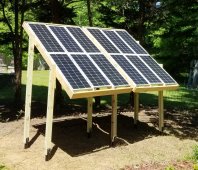It's been almost 2 years since I ordered the first two panels and set up a small proof of concept with a single 12v AGM battery.
Another ten panels, 7.3kWh LiFePO4 battery bank, 24v inverter, and a transfer switch later, it's finally powering my home office.
(Note that this system is not intended to power the whole house and is not even tied into the house wiring except for earth ground.)
It still needs some tweaks: a couple of in-line fuses, the batteries should be wrapped, the panels need to be grounded, and I need to do some more pruning (you can see the shadow near the right-side of the panels). Other than that I'm happy with everything so far, and managed to do it without electrocuting myself.
Specs:
12x 100-watt Richsolar panels (the last 4 were a different size than the first 8): https://www.amazon.com/gp/product/B07DW8YNMF/ ($90ea, $1080 total)
A PV combiner box (6-parallel, 2-series) https://www.amazon.com/gp/product/B01N96GJFT/ ($166)
60A MPPT (40A probably would've been sufficient - Amazon doesn't sell this particular one anymore) ($100)
8x 285Ah grade A cells https://www.alibaba.com/product-detail/Grade-A-105Ah-200Ah-280Ah-3_62448638595.html ($82ea during a promotion, $874 w/ shipping)
Daly 200A 24V BMS https://www.aliexpress.com/item/32891427621.html ($173 w/ shipping)
3000W 24V inverter https://www.amazon.com/gp/product/B01M5L0A5L/ ($389)
Automatic transfer switch https://www.amazon.com/gp/product/B07F12RDZ2/ ($119)
Wires, mounting hardware, lumber, screws, etc. (about $750)
OVERALL TOTAL: $3,651 (not counting the "proof of concept" components that aren't in the final build)


Given the low consumption my house uses already, it could theoretically pay for itself in 6-10 years.
Anyway, I'd like to give a big shout out to Will for the great Youtube videos that helped me with this, and all of the other useful info I've found on these forums.
Thanks all!
Another ten panels, 7.3kWh LiFePO4 battery bank, 24v inverter, and a transfer switch later, it's finally powering my home office.
(Note that this system is not intended to power the whole house and is not even tied into the house wiring except for earth ground.)
It still needs some tweaks: a couple of in-line fuses, the batteries should be wrapped, the panels need to be grounded, and I need to do some more pruning (you can see the shadow near the right-side of the panels). Other than that I'm happy with everything so far, and managed to do it without electrocuting myself.
Specs:
12x 100-watt Richsolar panels (the last 4 were a different size than the first 8): https://www.amazon.com/gp/product/B07DW8YNMF/ ($90ea, $1080 total)
A PV combiner box (6-parallel, 2-series) https://www.amazon.com/gp/product/B01N96GJFT/ ($166)
60A MPPT (40A probably would've been sufficient - Amazon doesn't sell this particular one anymore) ($100)
8x 285Ah grade A cells https://www.alibaba.com/product-detail/Grade-A-105Ah-200Ah-280Ah-3_62448638595.html ($82ea during a promotion, $874 w/ shipping)
Daly 200A 24V BMS https://www.aliexpress.com/item/32891427621.html ($173 w/ shipping)
3000W 24V inverter https://www.amazon.com/gp/product/B01M5L0A5L/ ($389)
Automatic transfer switch https://www.amazon.com/gp/product/B07F12RDZ2/ ($119)
Wires, mounting hardware, lumber, screws, etc. (about $750)
OVERALL TOTAL: $3,651 (not counting the "proof of concept" components that aren't in the final build)


Given the low consumption my house uses already, it could theoretically pay for itself in 6-10 years.
Anyway, I'd like to give a big shout out to Will for the great Youtube videos that helped me with this, and all of the other useful info I've found on these forums.
Thanks all!


